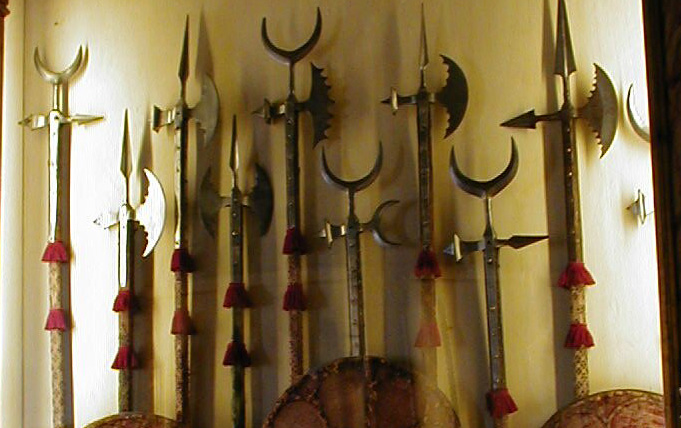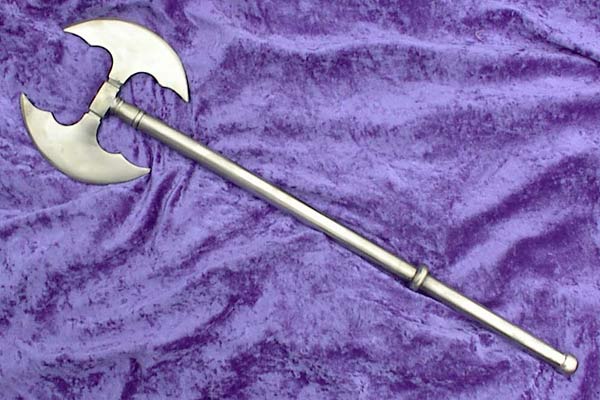If you really think about it what would be the point of a double headed axe in combat? Catching someone on the backswing after your initial stroke wouldn't hit nearly as hard as simply rotating your wrists, and swinging the main edge towards the second target.
What's the point of a double bitted axe when felling trees then?
I have no idea. Different edge geometry on each end?
You keep one edge really keen for working on the tree trunks. The other edge duller for work closer to the ground.
As far as I've gathered, the two edges have a different geometry, for different uses.
Also, it means that you dont need to stopp to sharpen your axe as often.
Personally, I don't think enough blows are traded in a battle to warrant a fresh edge, even though the sagas describes this on occasion....
Also, it means that you dont need to stopp to sharpen your axe as often.
Personally, I don't think enough blows are traded in a battle to warrant a fresh edge, even though the sagas describes this on occasion....
The addition of a spike or hammer to the off-side of the head is probably better that another blade. It adds versatility to the weapon's function. That's probably why we see more of that in surviving examples than the double-bladed variety.
I have to go with the thory of less sharpening. Assuming I'm a medieval woodsman, and I plan to cut wood ALL FREAKIN DAY, I can A: carry two axes, or B: carry one double axe or C: carry a grinding wheel out to the job site. Hmmm.
"Give me six hours to chop down a tree and I will spend the first four sharpening the axe" - Abe Lincoln
"Give me six hours to chop down a tree and I will spend the first four sharpening the axe" - Abe Lincoln
perhaps double headed axes are more balanced than a single or perhaps it saves on the need to sharpen the blade since you have a backup
Hello everyone,
I handled a A&A tabor some 7 years ago and seem to remeber being impressed with the balance. I can say that with my Danish having a rather substantial blade is felt in the hands when wielded. I wonder to what century the tabor is attributed.
Jeremy
I handled a A&A tabor some 7 years ago and seem to remeber being impressed with the balance. I can say that with my Danish having a rather substantial blade is felt in the hands when wielded. I wonder to what century the tabor is attributed.
Jeremy
| Patrick Kelly wrote: |
| The addition of a spike or hammer to the off-side of the head is probably better that another blade. It adds versatility to the weapon's function. That's probably why we see more of that in surviving examples than the double-bladed variety. |
Like this?
[ Linked Image ]
I WANT ONE! :cry:
These polearms were in the armory of the Doge's Palace, Venice, Italy. Look at the fourth pollaxe from the left.
 Attachment: 122.93 KB
Attachment: 122.93 KB


Alex;
Thanks for the picture: Good grief :eek: :eek: :eek: If I drew any of these and asked someone to make a custom version everybody would assume " Fantasy " design: We do tend to always see the more usual or conventional pictures of typical polearms to the point that we tend to have an oversimplified idea of what was " historical ".
We really need more books on polearms :lol:
Thanks for the picture: Good grief :eek: :eek: :eek: If I drew any of these and asked someone to make a custom version everybody would assume " Fantasy " design: We do tend to always see the more usual or conventional pictures of typical polearms to the point that we tend to have an oversimplified idea of what was " historical ".
We really need more books on polearms :lol:
Now, it is quite posible that a lot of these are seremonial/parade weapons...
| Elling Polden wrote: |
| Now, it is quite posible that a lot of these are seremonial/parade weapons... |
Possible, or they could have been specialized for duels (judicial or otherwise). If you look at one of the Talhoffer texts (not the 1467, but the others are harder to find), you'll see some really odd polearms actually being used in combat. Just because it's odd, that doesn't mean it wasn't used on occasion.
Or maybe " fantasy " weapons is not a totally modern phenomenon. :eek: :lol:
A late period weapon type: Still in use as a type in simpler form but coexisting in time with less practical display pieces?
A bit of experimentation combining features of of different types into one maybe ?
Some of the wilder hooks and serrations don't seem to be in a place where they would add to functionality of some of these.
The whole form follows function idea is a modern one: Ornate decoration for its' own sake can in some cases be functional,
have no impact on function or actually impair function.
A late period weapon type: Still in use as a type in simpler form but coexisting in time with less practical display pieces?
A bit of experimentation combining features of of different types into one maybe ?
Some of the wilder hooks and serrations don't seem to be in a place where they would add to functionality of some of these.
The whole form follows function idea is a modern one: Ornate decoration for its' own sake can in some cases be functional,
have no impact on function or actually impair function.
The trouble with the polearms from the Doges Palace is just that: they are polearms, and really fall into a seperate category (at least as I look at it) than a battle axe.
Therefore let me reiterate my purpose and quest: Are there any actual surviving examples of the ubiquitous doublebladed fantasy axe; haft length 18 - 40 inches, specialized for warfare, i.e. a narrow blade. This should be an example from Europe, not a poleaxe, and not designed for ceremony.
I realize this may be a futile search, but now I've just got to know. Perhaps the reason it's hard to find is that weapons of this type were simply used up, or returned to agricultural service.
I've posted or attempted to post a picture that should summarize this concept.
 Attachment: 7.09 KB
Attachment: 7.09 KB

Therefore let me reiterate my purpose and quest: Are there any actual surviving examples of the ubiquitous doublebladed fantasy axe; haft length 18 - 40 inches, specialized for warfare, i.e. a narrow blade. This should be an example from Europe, not a poleaxe, and not designed for ceremony.
I realize this may be a futile search, but now I've just got to know. Perhaps the reason it's hard to find is that weapons of this type were simply used up, or returned to agricultural service.
I've posted or attempted to post a picture that should summarize this concept.

Here is a photo of A&A's now-discontinued #009 Taber Axe.
 Attachment: 47.51 KB
Attachment: 47.51 KB

A&A #009 Taber Axe (Discontinued)

A&A #009 Taber Axe (Discontinued)
I believe they were not that popular in western europe. Their were most likely a few in circulation that probably originated in the east where things like that were more popular. Probably not carried by a knight but something along the lines of a man at arms. Generaly speaking when ever their is only a few of something not much is written about unless the one using it becomes famous. And of coarse their are probably exceptions to this. The following is a current explanation on double bitted axes from the Gränsfors Bruks web site. They make some of if not the best axes available.
Different models of double-bit axes have been popular in the US since the last quarter of the 19th century because of its balanced feel and versatility. Typically, one blade was sharpened to a finely honed, narrow “felling edge”, while the second blade was ground slightly blunter, and used for knots and cutting near the ground where a finely sharpened blade was more likely to be damaged. Today the double-bit axe is used as a Working Axe or as a Throwing Axe for timber sports.
Different models of double-bit axes have been popular in the US since the last quarter of the 19th century because of its balanced feel and versatility. Typically, one blade was sharpened to a finely honed, narrow “felling edge”, while the second blade was ground slightly blunter, and used for knots and cutting near the ground where a finely sharpened blade was more likely to be damaged. Today the double-bit axe is used as a Working Axe or as a Throwing Axe for timber sports.
I know you are looking for examples from Western Europe, but I was having a look in Anthony C. Tirri's "Islamic Weapons, Maghrib to Moghul" when I found several double-headed axes. One of them was a 19th century Sudanese axe, which does look like a fighting axe and may have been used by one of the Mahdi's warriors. The remainder are Indian and Iranian, they are so ornately decorated they were probably ceremonial weapons or "bazaar pieces".
| Daniel Staberg wrote: |
| Pictorial evidence is generaly the hardest kind of of source to used, it is hard to determine what is based on a real object the artist has seen and what is "artistic licence" unless a picture can be supported by documentary and archeological sources as well.
For example One well know drawing of an event at the battle of Bouvines 1214 show a mailed mounted archer armed with a composite bow. Does this mean that the victorious French army employed mounted archery? [ Linked Image ] |
Possibly. In "the Great Warbow", Matthew Strickland cites evidence for the use of composite bows in Northwestern Europe in the very late 12th and through the 13th century. Possibly these were used by turcopoles returning from crusade with their masters. Richard I apparently brought some "Saracen" (probably Turcopoles) archers back with him as well.
Interestingly, there are some bows that appear to be composite bows in the Mispronouncski Bible, though it is difficult to tell if they are portrayimg weapons actually used in France at the time.
Mike
Page 2 of 4
You cannot post new topics in this forumYou cannot reply to topics in this forum
You cannot edit your posts in this forum
You cannot delete your posts in this forum
You cannot vote in polls in this forum
You cannot attach files in this forum
You can download files in this forum
All contents © Copyright 2003-2006 myArmoury.com — All rights reserved
Discussion forums powered by phpBB © The phpBB Group
Switch to the Full-featured Version of the forum
Discussion forums powered by phpBB © The phpBB Group
Switch to the Full-featured Version of the forum